Growing up in our small coastal town of Pilar, Bataan, catching alimasag was more than just fishing, it was our childhood adventure, I remember waking up at dawn with my Tatay and my best friend, armed with our trusty nets and bait, racing against the sunrise to catch these feisty blue crabs.
Back home, my Nanay would transform our fresh catch into this incredible Ginataang Alimasag that had everyone fighting over the last drop of that creamy gata sauce.
Now living in the city, this recipe brings back those seaside memories with every bite. The secret? It's all in how you let the coconut milk slowly simmer with the crab, creating that rich, golden sauce that's just begging to be soaked up with hot rice.
Once you master this ginataang alimasag recipe, you'll understand why we Filipinos can't help but eat this with our hands. There's just no other way to fully enjoy every succulent piece of crab meat swimming in that velvety gata sauce.
Jump to:
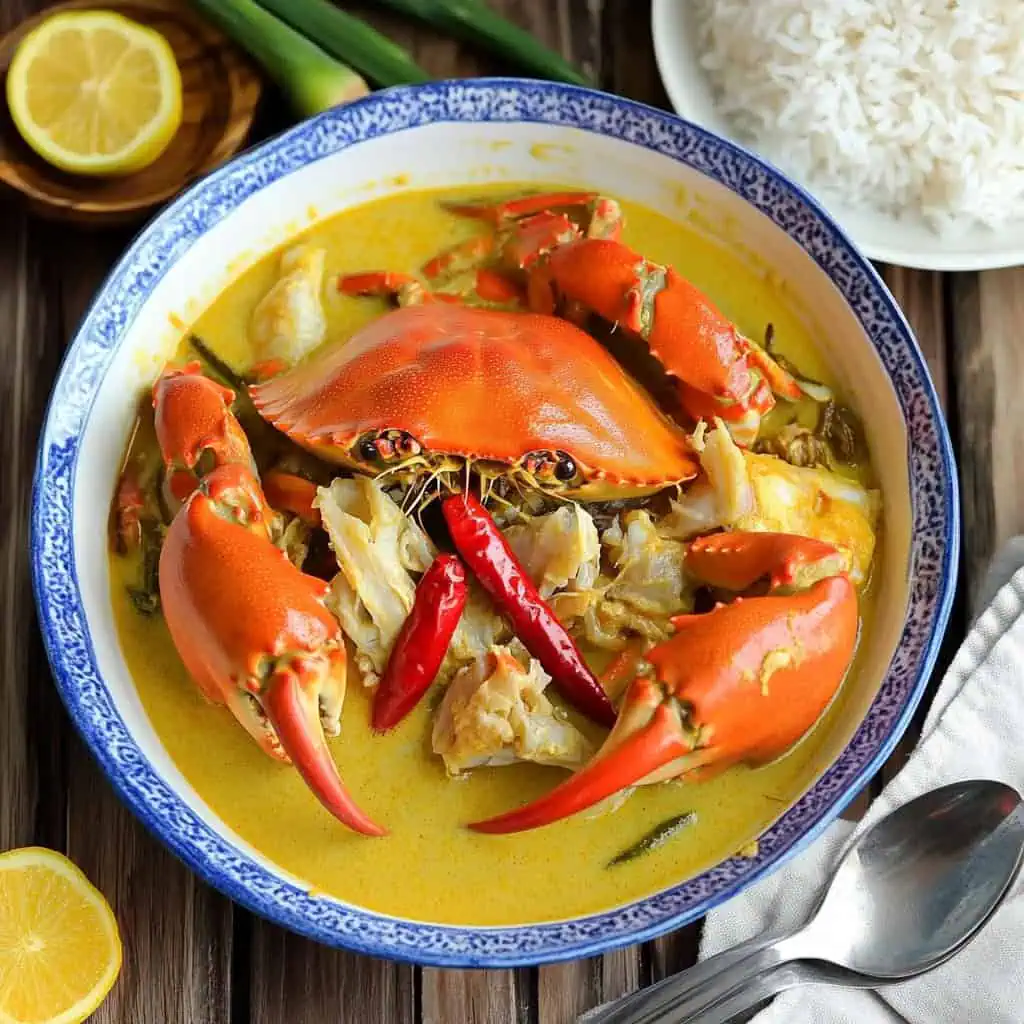
Why You'll Love This Recipe
- Restaurant-Quality Results: Create the same rich, creamy flavors you'd find in high-end Filipino seafood restaurants
- Perfect for Special Occasions: Impressive enough for celebrations but simple enough for weekend family meals
- Complete Meal: With vegetables already included, just add rice for a complete Filipino feast
- Authentically Filipino: Traditional techniques and ingredients passed down through generations
- Versatile: Can be adjusted for spice levels and vegetable preferences
- Nutrient-Rich: High in protein, healthy fats, and essential minerals from seafood and coconut milk
Ingredients
Each element in this dish serves a specific purpose in creating the perfect flavor balance. The sweet, succulent blue crabs form the heart of the dish, while coconut milk and cream provide a luxurious base.
Aromatics like onion, garlic, and ginger create depth, while Thai chilies add gentle heat. Fish sauce contributes essential umami, and vegetables like calabasa and long beans add contrasting textures and colors while soaking up the rich sauce.
Together, they create a harmonious blend of sweet, savory, spicy, and creamy that defines authentic Filipino coastal cuisine.
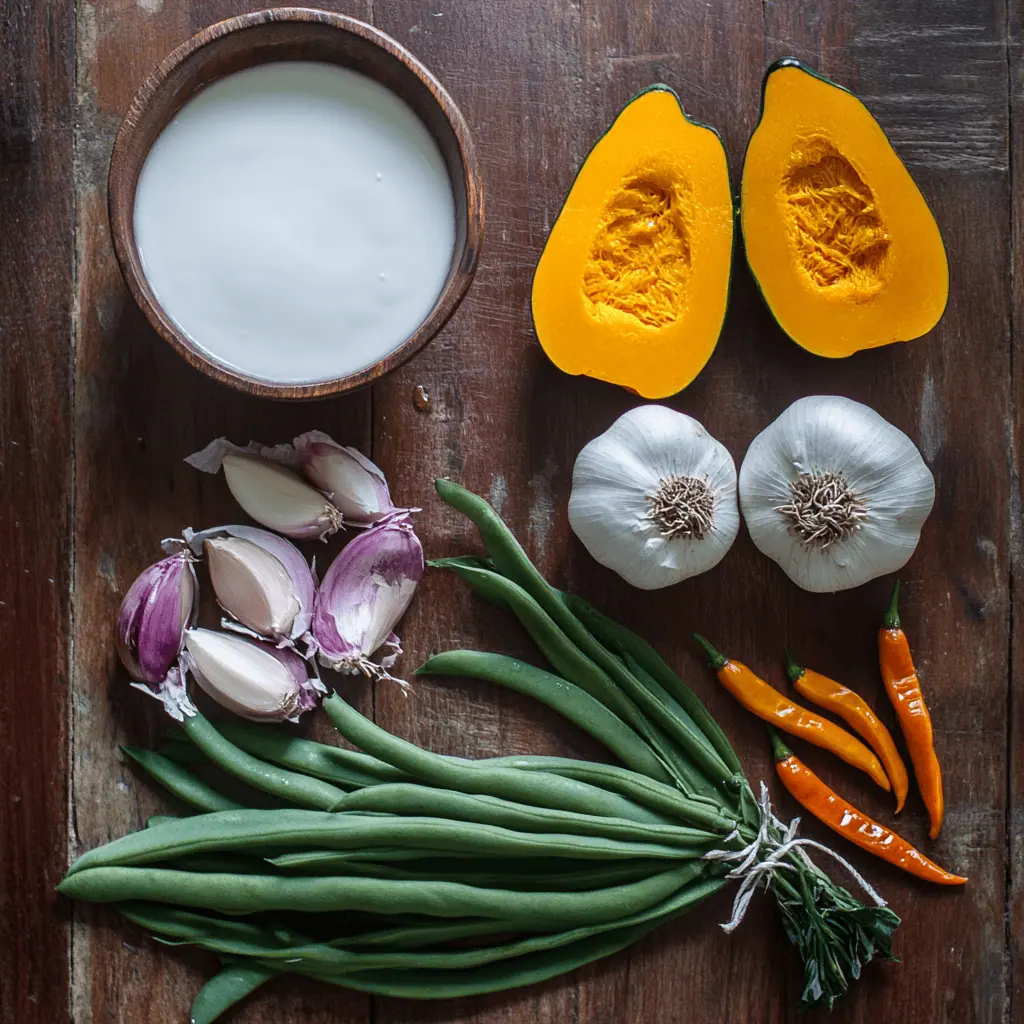
- 6 blue crabs (alimasag): Select crabs that feel heavy for their size.
- 4 cups coconut milk (gata): Provides the creamy base of the dish.
- 1 cup coconut cream (kakang gata): Adds richness and thickness to the sauce.
- 1 onion, chopped: Adds aromatic foundation.
- 5 cloves garlic, minced: Provides essential flavor profile.
- 1 thumb-size ginger, julienned: Adds warmth and counterbalances the richness.
- 4 Thai chili peppers (siling labuyo): Brings pleasant heat to the dish.
- 1 tablespoon fish sauce (patis): Delivers umami depth.
- 1 small calabasa/squash, cubed: Adds sweetness and texture.
- 1 bunch long beans, cut into 2-inch lengths (sitaw): Provides color and texture contrast.
- 1 tablespoon cooking oil: For sautéing the aromatics.
- Salt and pepper to taste: For final seasoning adjustments.
Equipment
- Large Steamer: For perfectly cooking the crabs without losing their natural flavor and moisture. The steaming process helps preserve the delicate crab meat texture while making it easier to handle later.
- Large Wok or Deep Pan: A 12-inch wok or deep pan allows enough space for the crabs and vegetables to simmer properly in the coconut milk. The wide surface area helps the sauce reduce and thicken evenly.
- Wooden Spoons: Wooden utensils are gentler on the delicate crab shells and won't scratch your cookware while stirring the coconut milk.
- Kitchen Scissors: Makes cutting through tough crab shells easier when preparing them for cooking.
- Instant-Read Thermometer: Helps monitor liquid temperature to prevent the coconut milk from boiling and curdling.
- Sharp Knife and Cutting Board: For preparing vegetables and aromatics.
- Finger Bowls: Small bowls with warm water and calamansi for cleaning hands while eating.
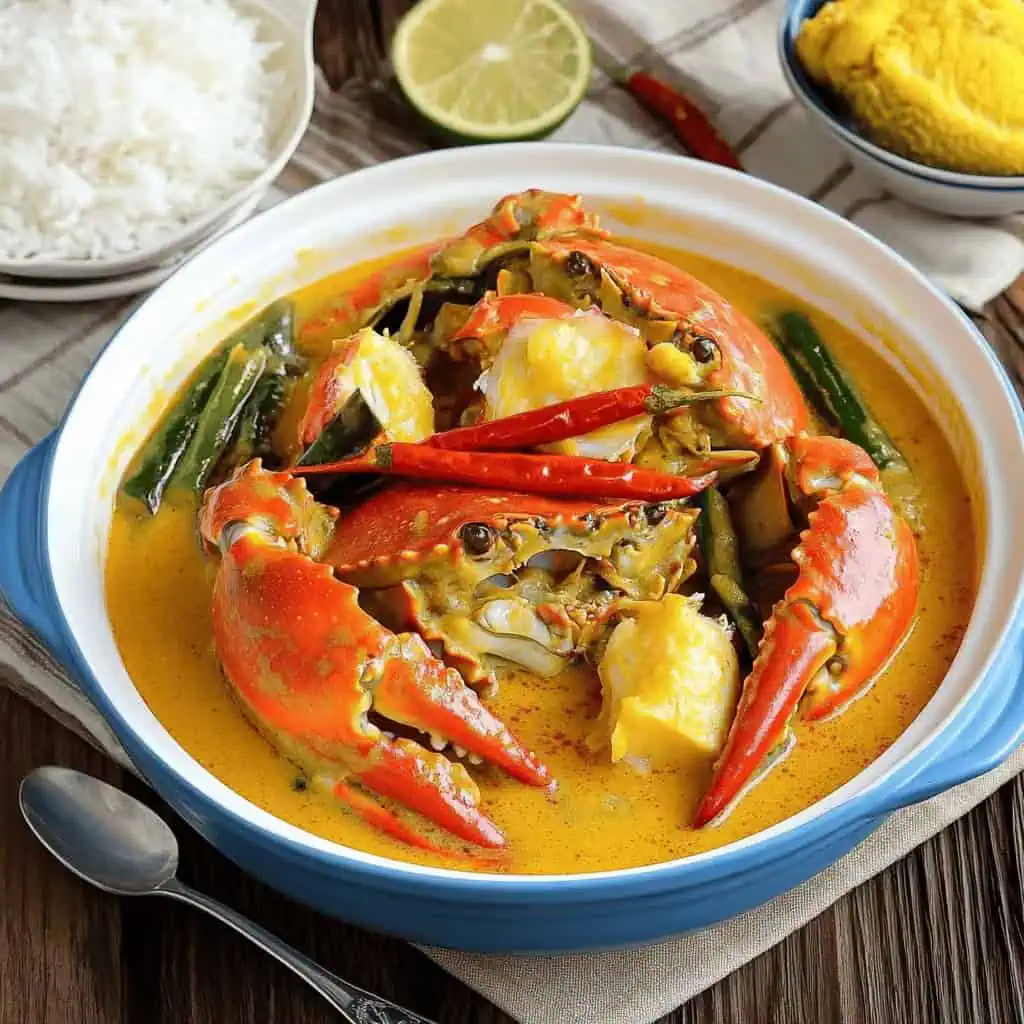
How To Make
- Thoroughly clean the crabs (alimasag) under running water. Remove the gills (hasang) and innards (bituka) carefully. Lightly scrub the shells to remove any dirt or debris. Check that each crab feels heavy for its size - this ensures you're using meaty crabs.
- Fill your steamer with water and bring it to a full boil at 212°F (100°C). Place the cleaned crabs belly-side down in the steamer basket, making sure they're not overcrowded. Steam the crabs for 20-25 minutes until their shells turn bright orange-red. You'll know they're done when the shells have completely changed color.
- While the crabs are steaming, prepare your vegetables. Chop the onions, mince the garlic, and julienne the ginger. Cut the calabasa squash into uniform 1-inch cubes and trim the long beans into 2-inch lengths.
- Heat your large pan or wok over medium heat (175°F/80°C). Add the cooking oil and wait until it shimmers. Add your chopped onions first and cook them until they become transparent, which takes about 3 minutes. Stir occasionally using a wooden spoon.
- Add the minced garlic and julienned ginger to the pan. Cook these aromatics until you can smell their fragrance, usually 1-2 minutes. Add the fish sauce and cook for another minute, stirring to combine all the flavors.
- Now comes the most crucial step - adding the coconut milk. Pour the coconut milk into the pan slowly while stirring in one direction. Bring the mixture to a gentle simmer at 185°F (85°C). Remember, never let it reach a full boil as this will cause the coconut milk to separate. Reduce the heat to low (165°F/74°C) and let it simmer for 10 minutes, stirring occasionally but always in the same direction.
- Add the cubed calabasa to the simmering coconut milk. Cook for 5 minutes or until the squash begins to soften but isn't mushy. Test the tenderness with a fork - it should offer some resistance but not be hard.
- Add the cut long beans to the pan. Cook for 3 minutes until they turn bright green but remain crisp. They should bend slightly but still snap when folded.
- Gently place your steamed crabs into the simmering coconut milk mixture. Pour in the coconut cream and add the Thai chili peppers whole. If you want the dish spicier, you can slice the chilies before adding.
- Let everything simmer together for 8-10 minutes at low heat until the sauce thickens enough to coat the back of your spoon. Stir very gently to avoid breaking the crab pieces. The oil from the coconut cream should rise to the surface, creating small orange pools - this is a good sign.
- Taste the sauce and season with salt and pepper as needed. If you want more saltiness, you can add a little more fish sauce instead of salt. The final sauce should be creamy and rich but not too thick - it should easily pour over rice but not be watery.
- Once done, let the dish rest for 2-3 minutes before serving. This allows the flavors to settle and the sauce to reach the perfect consistency. Serve immediately in a large bowl with plenty of hot steamed rice. Place calamansi halves and extra fish sauce on the side for diners to adjust flavors to their taste.
- Remember to provide finger bowls with warm water and calamansi for cleaning hands, as this dish is traditionally eaten kamayan style (using hands). The best way to enjoy Ginataang Alimasag is to crack the crab shells with your hands and use your fingers to get every bit of meat, dipping each piece in the rich coconut sauce before eating with rice.

Tips from Lola's Kitchen
Selecting the Perfect Crabs:
- Press the pointy sides of the crab - if they feel hollow, there's little meat inside
- Look for crabs with a firm triangular abdominal plate (apron) as these contain the meatiest flesh
- Choose crabs that feel heavy for their size, indicating more meat inside
- Fresh crabs should smell pleasantly like the ocean, never fishy or ammonia-like
- If possible, select male crabs (wider triangular plate) for more claw meat and females (rounded plate) for delicious aligue (crab fat)
Mastering Coconut Milk:
- Use fresh or high-quality canned coconut milk (not coconut cream) for the main cooking liquid
- Save the thicker coconut cream for the final stages to achieve that luxurious mouthfeel
- NEVER let coconut milk reach a rapid boil - maintain a gentle simmer around 185°F
- Stir consistently in one direction to prevent the coconut milk from breaking and becoming grainy
- If your sauce looks too thin, continue simmering gently until it reaches desired consistency
- Adding a pinch of sugar can help balance flavors if your coconut milk lacks natural sweetness
Enhancing Flavor Depth:
- Toast the ginger and garlic until fragrant before adding other ingredients
- Lightly season the crabs with salt before steaming to enhance their natural sweetness
- For an aromatic twist, add 2-3 kaffir lime leaves to the simmering coconut milk
- Reserve a tablespoon of coconut cream to drizzle on top just before serving
- Use a mortar and pestle to slightly crush the Thai chilies before adding for more complex heat
- A squeeze of calamansi juice at the end brightens all the flavors without overwhelming the dish
Perfecting the Cooking Process:
- Don't rush the steaming process - properly steamed crabs are easier to handle and more flavorful
- Allow the sauce to reduce naturally rather than adding thickeners
- The calabasa should be soft enough to easily pierce with a fork but still hold its shape
- Keep the long beans slightly crisp for textural contrast against the tender crab and soft squash
- Let the dish rest for a few minutes after cooking to allow flavors to fully develop
Substitutions
- Coconut Milk: If unavailable, mix coconut milk powder with water following package instructions. For a richer alternative, use 3 parts coconut milk and 1 part heavy cream.
- Blue Crabs: Mud crabs work wonderfully with their sweet meat, or try dungeness crabs for larger, meatier portions. Snow crab legs can work in a pinch but require adjusted cooking times.
- Long Beans: Standard green beans or string beans provide similar texture and flavor. Sugar snap peas or snow peas can add a pleasant sweetness and crunch.
- Calabasa: Butternut squash, kabocha, or even sweet potatoes offer similar sweetness and texture. Adjust cooking time as needed since some squash varieties cook faster than others.
- Thai Chilies: Bird's eye chilies maintain the authentic heat level, while jalapeños or serrano peppers offer a milder alternative. For a completely different dimension, try a teaspoon of sambal oelek or gochujang.
- Fish Sauce: Shrimp paste (bagoong) provides similar umami depth (use half the amount). For those avoiding seafood-based condiments, tamari or coconut aminos with a pinch of salt can approximate the savory qualities.
- Aromatics: Lemongrass can be added alongside or in place of some ginger for a citrusy note. Shallots can replace onions for a more delicate flavor profile.
Troubleshooting
Curdled Coconut Milk:
- Problem: Sauce looks grainy or separated
- Solution: Immediately lower heat and gently stir in one direction. In severe cases, transfer to a new pot, add a little fresh coconut milk, and warm very gently.
- Prevention: Never let the coconut milk boil; maintain a gentle simmer below 185°F. Stir consistently in one direction when heating.
Tough Crab Meat:
- Problem: Crab meat is rubbery or difficult to chew
- Solution: If during cooking, extend the simmering time at a very low temperature. If already finished, serve with extra sauce and fresh lime to help tenderize.
- Prevention: Don't overcrowd the steamer. Steam at proper temperature until shells are completely bright orange-red before adding to the coconut milk.
Watery Sauce:
- Problem: Sauce is too thin and doesn't cling to the crab or rice
- Solution: Continue simmering uncovered on low heat, stirring occasionally until reduced to desired consistency. Never add flour or cornstarch.
- Prevention: Use the proper ratio of coconut milk to coconut cream (4:1). Allow proper reduction time during the final simmering stage.
Bland Flavor:
- Problem: Dish lacks depth despite following the recipe
- Solution: Add fish sauce one teaspoon at a time, allowing it to incorporate before tasting again. A dash of calamansi juice can brighten flavors.
- Prevention: Use fresh, high-quality ingredients. Toast aromatics properly before adding liquids. Ensure proper salt balance throughout cooking.
Vegetables Too Soft:
- Problem: Calabasa and long beans are mushy instead of tender-crisp
- Solution: Unfortunately, this can't be fixed once overcooked. Serve immediately and adjust next time.
- Prevention: Add vegetables in stages according to cooking time requirements. Test frequently with a fork for doneness.
Too Spicy:
- Problem: Heat level is overwhelming the delicate crab flavor
- Solution: Add more coconut cream to mellow the heat. Serve with extra rice and a cooling side dish.
- Prevention: Keep chilies whole instead of slicing. Remove them before serving if desired, or use fewer chilies initially.
Storage & Reheating
Refrigeration:
- Store leftovers in an airtight container for up to 3 days.
- For best results, separate the crab and vegetables from the sauce when storing.
- The coconut sauce will naturally solidify when cold – this is normal.
Freezing:
- Not recommended for this dish as the texture of both the crab meat and vegetables significantly deteriorates when frozen and thawed.
- If absolutely necessary, freeze only the sauce portion for up to 1 month.
Reheating on Stovetop (Preferred Method):
- Transfer to a heavy-bottomed pan.
- Add 2-3 tablespoons of fresh coconut milk or water to loosen the sauce.
- Heat over very low heat, stirring gently and consistently.
- Warm until just heated through, about 5-7 minutes, never allowing it to boil.
- Check seasoning as you may need to adjust with a dash of fish sauce.
Reheating in Microwave (Quick Method):
- Place in a microwave-safe container.
- Cover loosely, leaving a vent for steam.
- Heat at 50% power in 1-minute intervals, stirring between each interval.
- Stop as soon as warmed through to prevent overcooking the crab meat.
- If sauce is too thick, stir in a tablespoon of warm coconut milk.
Note: While reheated Ginataang Alimasag is still delicious, the texture of the crab meat will be slightly different than when freshly made. The sauce may also be thicker and might need thinning with fresh coconut milk.
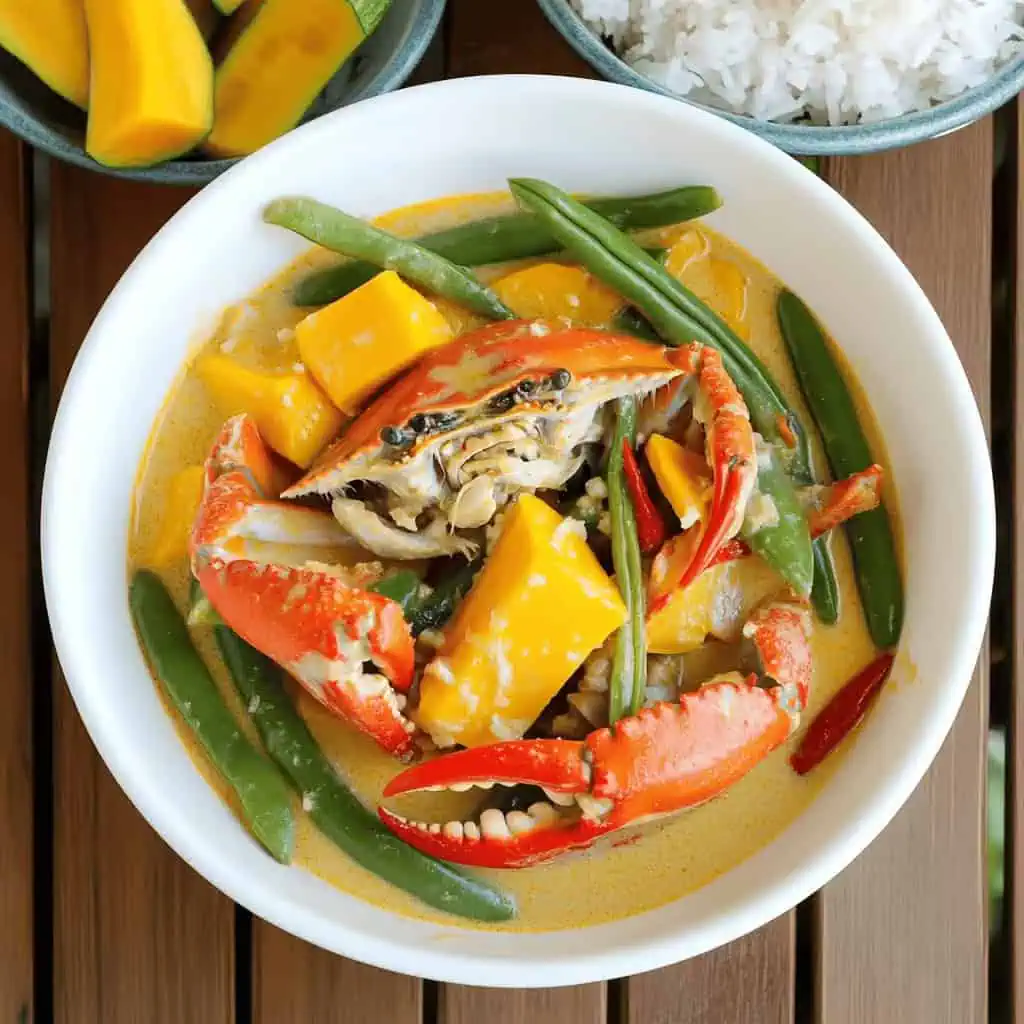
FAQ
Can I use frozen crabs for this recipe?
Yes, you can use frozen crabs, but for best results, thaw them completely in the refrigerator overnight and pat dry before cooking. Frozen crabs may release more water during cooking, so you might need to simmer the sauce a bit longer to reach the desired consistency.
How do I know when the crabs are fully cooked?
Properly cooked crabs will have shells that have turned completely bright orange-red, and the meat will be opaque and white with a firm but tender texture. Undercooked crab meat appears translucent and gelatinous, while overcooked meat becomes tough and stringy.
Can I make Ginataang Alimasag in advance for a party?
While best served fresh, you can prepare this dish 4-6 hours ahead. Steam and clean the crabs, prepare the vegetables, and make the coconut milk base separately. About 30 minutes before serving, gently reheat the coconut base and add the crabs and vegetables to finish the cooking process.
How spicy is this dish traditionally?
Authentic Ginataang Alimasag is moderately spicy, with the heat coming from whole Thai chilies that infuse the sauce without overwhelming it. The spice level is easily adjustable—use fewer chilies for a milder version or slice them to release more heat if you prefer a spicier dish.
Can I add other seafood to this recipe?
Absolutely! Many Filipino households create a seafood medley version by adding shrimp, mussels, or squid. If incorporating other seafood, add them according to their cooking times, squid and shrimp cook much faster than crabs, so add them in the final 3-4 minutes of cooking.
What's the best rice to serve with Ginataang Alimasag?
Jasmine rice or any long-grain white rice works perfectly. The slightly sticky texture helps scoop up the sauce, while its subtle fragrance complements the dish without competing with the delicate flavors of the crab and coconut milk.
Is there a vegetarian alternative to this dish?
While the crab is essential to authentic Ginataang Alimasag, the cooking technique works wonderfully for a vegetarian ginataan. Substitute the crab with firm tofu, mushrooms (king oyster mushrooms work well), and young jackfruit. Replace fish sauce with soy sauce or vegetarian mushroom sauce for umami depth.
How do I crack the crab shells efficiently when eating?
Use your hands or seafood crackers for the larger shells. For claw meat, crack at the joints rather than the thickest part. The back fins often contain hidden pockets of meat that can be accessed by gently pulling the fin away from the body. Don't forget the body cavity, which contains some of the sweetest meat.
What makes the coconut sauce curdle, and how can I prevent it?
Coconut milk curdles when proteins coagulate due to high heat or acidity. To prevent curdling: never boil the coconut milk, maintain a gentle simmer, stir consistently in one direction, add acidic ingredients like calamansi juice only at the end of cooking, and use fresh or high-quality coconut milk products.
Can I use coconut milk in cartons instead of canned?
Coconut milk in cartons is typically more diluted and contains additives for shelf stability. While it can work in a pinch, the sauce won't develop the same richness. If using carton coconut milk, reduce the amount by about 25% and increase the coconut cream portion to compensate for the lower fat content.
Related
Looking for other recipes like this? Try these:

Authentic Ginataang Alimasag (Filipino Crab in Coconut Milk)
Ingredients
- 6 blue crabs alimasag
- 4 cups coconut milk gata
- 1 cup coconut cream kakang gata
- 1 onion chopped (sibuyas)
- 5 cloves garlic minced (bawang)
- 1 thumb-size ginger julienned (luya)
- 4 Thai chili peppers siling labuyo
- 1 tablespoon fish sauce patis
- 1 small calabasa/squash cubed (kalabasa)
- 1 bunch long beans cut into 2-inch lengths (sitaw)
- 1 tablespoon cooking oil mantika
- Salt and pepper to taste asin at paminta
Instructions
- Start by thoroughly cleaning the crabs (alimasag) under running water. Remove the gills (hasang) and innards (bituka) carefully. Lightly scrub the shells to remove any dirt or debris (kuskusin ang shell para matanggal ang dumi). Check that each crab feels heavy for its size - this ensures you're using meaty crabs.
- Fill your steamer with water and bring it to a full boil at 212°F (100°C). Place the cleaned crabs belly-side down in the steamer basket, making sure they're not overcrowded. Steam the crabs for 20-25 minutes until their shells turn bright orange-red. You'll know they're done when the shells have completely changed color (kapag naging orange-pula na ang balat).
- While the crabs are steaming, prepare your vegetables. Chop the onions (sibuyas), mince the garlic (bawang), and julienne the ginger (luya). Cut the calabasa squash (kalabasa) into uniform 1-inch cubes and trim the long beans (sitaw) into 2-inch lengths.
- Heat your large pan or wok (kawali) over medium heat (175°F/80°C). Add the cooking oil (mantika) and wait until it shimmers. Add your chopped onions first and cook them until they become transparent, which takes about 3 minutes. Stir occasionally using a wooden spoon (sandok na kahoy).
- Add the minced garlic and julienned ginger to the pan. Cook these aromatics until you can smell their fragrance (hanggang mabango), usually 1-2 minutes. Add the fish sauce (patis) and cook for another minute, stirring to combine all the flavors.
- Now comes the most crucial step - adding the coconut milk (gata). Pour the coconut milk into the pan slowly while stirring in one direction. Bring the mixture to a gentle simmer at 185°F (85°C). Remember, never let it reach a full boil as this will cause the coconut milk to separate. Reduce the heat to low (165°F/74°C) and let it simmer for 10 minutes, stirring occasionally but always in the same direction.
- Add the cubed calabasa to the simmering coconut milk. Cook for 5 minutes or until the squash begins to soften but isn't mushy (hanggang lumambot nang kaunti). Test the tenderness with a fork - it should offer some resistance but not be hard.
- Add the cut long beans to the pan. Cook for 3 minutes until they turn bright green but remain crisp (hanggang maging berde pero malutong pa rin). They should bend slightly but still snap when folded.
- Gently place your steamed crabs into the simmering coconut milk mixture. Pour in the coconut cream (kakang gata) and add the Thai chili peppers (siling labuyo) whole. If you want the dish spicier, you can slice the chilies before adding.
- Let everything simmer together for 8-10 minutes at low heat until the sauce thickens enough to coat the back of your spoon (hanggang lumapot ang sabaw). Stir very gently to avoid breaking the crab pieces. The oil from the coconut cream should rise to the surface, creating small orange pools - this is a good sign.
- Taste the sauce and season with salt and pepper (asin at paminta) as needed. If you want more saltiness, you can add a little more fish sauce instead of salt. The final sauce should be creamy and rich but not too thick - it should easily pour over rice but not be watery.
- Once done, let the dish rest for 2-3 minutes before serving. This allows the flavors to settle and the sauce to reach the perfect consistency. Serve immediately in a large bowl with plenty of hot steamed rice (mainit na kanin). Place calamansi halves and extra fish sauce on the side for diners to adjust flavors to their taste.
- Remember to provide finger bowls with warm water and calamansi for cleaning hands, as this dish is traditionally eaten kamayan style (using hands). The best way to enjoy Ginataang Alimasag is to crack the crab shells with your hands and use your fingers to get every bit of meat, dipping each piece in the rich coconut sauce before eating with rice.
Tips from Lola's Kitchen
- Crab Selection:
- Press the pointy sides - if hollow, there's no crab fat
- Look for a firm triangular plate for meatiest crabs
- Choose crabs that feel heavy for their size
- Fresh crabs should smell like the ocean, not fishy
- Coconut Milk Tips:
- Use first-press coconut milk for richest flavor
- Never let coconut milk boil rapidly to prevent curdling
- Stir in one direction when adding coconut milk
- Add coconut cream last for maximum richness
- Flavor Enhancement:
- Toast ginger and garlic before adding other ingredients
- Season crabs with salt before steaming
- Add kaffir lime leaves for extra aromatics (optional)
- Reserve some coconut cream for garnish
Nutrition
The Story Behind Ginataang Alimasag (Filipino Crab in Coconut Milk)
Growing up along the Philippines' endless coastlines, Ginataang Alimasag tells the story of our maritime heritage, where the abundance of fresh seafood meets the richness of tropical coconuts. This beloved Filipino crab dish, dating back generations, showcases how our ancestors masterfully combined the ocean's bounty with native ingredients to create something truly extraordinary.
In coastal communities from Batangas to Zambales, each family has their own version of this treasured recipe. Some say it originated from fisherfolk who needed hearty, filling meals after long days at sea. The combination was practical yet ingenious – fresh crabs, readily available coconut milk, and vegetables from backyard gardens. The dish became a testament to Filipino resourcefulness, turning simple ingredients into a feast fit for celebrations.
What makes Ginataang Alimasag stand out among countless Filipino ginataan dishes is its perfect balance. The natural sweetness of fresh blue crabs (alimasag) harmonizes with the creamy coconut milk (gata), while aromatics like ginger (luya) and garlic (bawang) add depth without overpowering the delicate seafood flavor. The addition of kalabasa (squash) and sitaw (long beans) isn't just for nutrition – these vegetables act as flavor sponges, soaking up the rich, golden sauce.
Today, whether served in humble seaside carinderias or upscale Filipino restaurants, Ginataang Alimasag remains a testament to our culinary heritage. It's more than just a recipe – it's a celebration of our coastal abundance, family gatherings, and the Filipino talent for transforming simple ingredients into something magical. Every family gathering or fiesta becomes extra special when this golden pot of creamy, crab-filled goodness takes center stage, surrounded by mountains of steaming rice and eager hands ready to dig in.
Modern Filipino home cooks might find it easier to buy pre-cleaned crabs from the market, but the essence remains the same – that magical moment when fresh seafood meets velvety coconut milk, creating a dish that tastes like memories of seaside feasts and family celebrations. Whether you're cooking this dish in a modern city kitchen or a traditional provincial home, each spoonful carries the legacy of countless Filipino cooks who perfected this coastal classic.
Remember: Perfect ginataang alimasag isn't just about the coconut milk sauce—it's about timing the cooking so the crab meat stays sweet and tender while allowing the sauce to reduce to that ideal creamy consistency that begs to be spooned over hot rice.
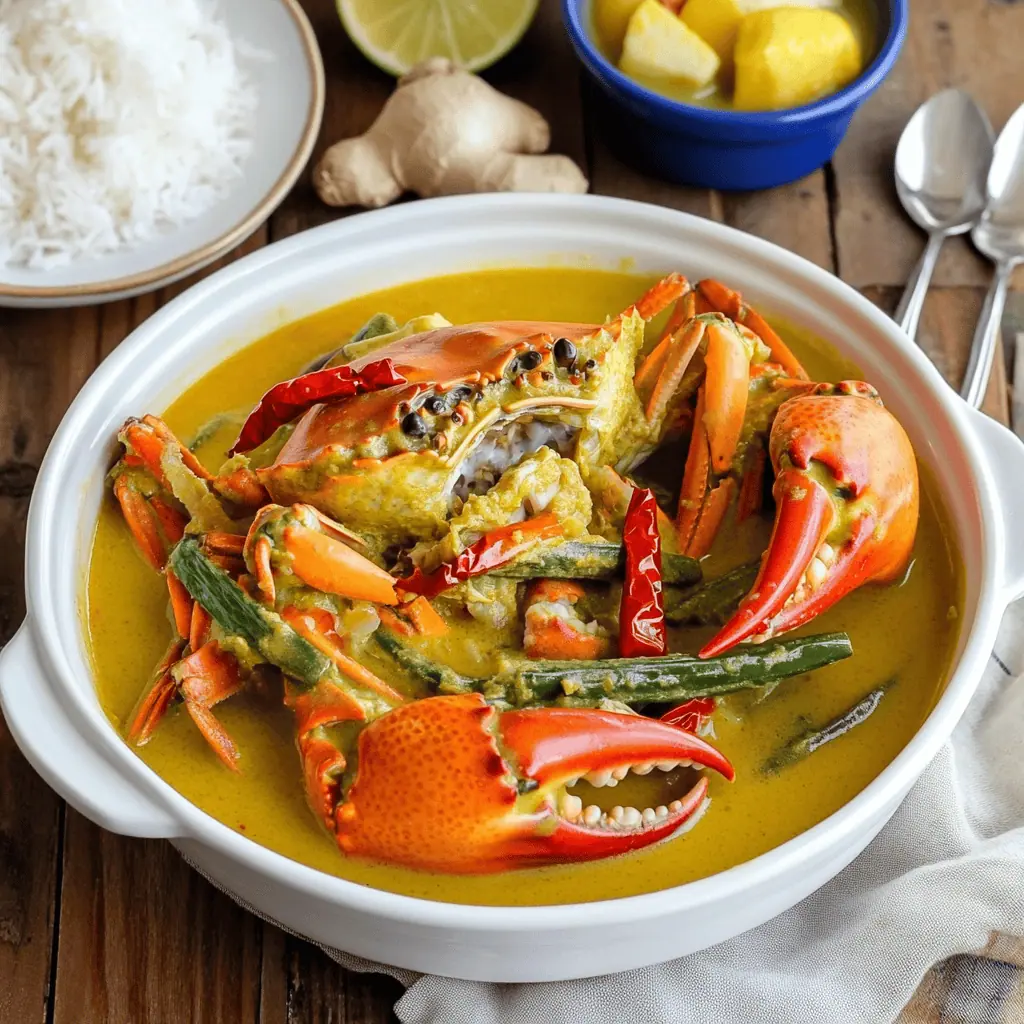






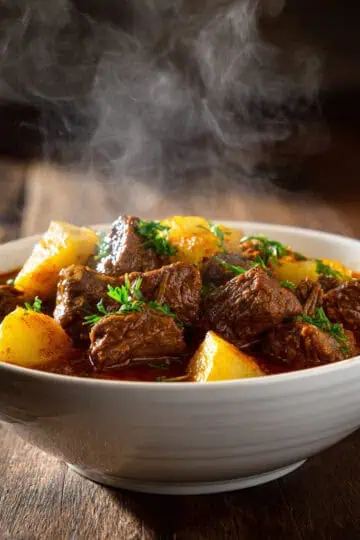


Comments
No Comments